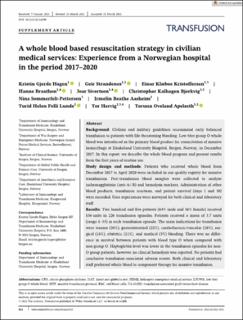| dc.contributor.author | Hagen, Kristin Gjerde | |
| dc.contributor.author | Strandenes, Geir | |
| dc.contributor.author | Kristoffersen, Einar Klæboe | |
| dc.contributor.author | Braathen, Hanne | |
| dc.contributor.author | Sivertsen, Joar | |
| dc.contributor.author | Bjerkvig, Christopher Kalhagen | |
| dc.contributor.author | Sommerfelt-Pettersen, Nina Grindheim | |
| dc.contributor.author | Aasheim, Irmelin Beathe | |
| dc.contributor.author | Lunde, Turid Helen Felli | |
| dc.contributor.author | Hervig, Tor | |
| dc.contributor.author | Apelseth, Torunn Oveland | |
| dc.date.accessioned | 2021-11-29T10:00:54Z | |
| dc.date.available | 2021-11-29T10:00:54Z | |
| dc.date.created | 2021-10-19T21:20:12Z | |
| dc.date.issued | 2021 | |
| dc.identifier.issn | 0041-1132 | |
| dc.identifier.uri | https://hdl.handle.net/11250/2831842 | |
| dc.description.abstract | Background: Civilian and military guidelines recommend early balanced transfusion to patients with life-threatening bleeding. Low titer group O whole blood was introduced as the primary blood product for resuscitation of massive hemorrhage at Haukeland University Hospital, Bergen, Norway, in December 2017. In this report, we describe the whole blood program and present results from the first years of routine use.
Study design and methods: Patients who received whole blood from December 2017 to April 2020 were included in our quality registry for massive transfusions. Post-transfusion blood samples were collected to analyze isohemagglutinin (anti-A/-B) and hemolysis markers. Administration of other blood products, transfusion reactions, and patient survival (days 1 and 30) were recorded. User experiences were surveyed for both clinical and laboratory staff.
Results: Two hundred and five patients (64% male and 36% female) received 836 units in 226 transfusion episodes. Patients received a mean of 3.7 units (range 1–35) in each transfusion episode. The main indications for transfusion were trauma (26%), gastrointestinal (22%), cardiothoracic/vascular (18%), surgical (18%), obstetric (11%), and medical (5%) bleeding. There was no difference in survival between patients with blood type O when compared with non-group O. Haptoglobin level was lower in the transfusion episodes for non-O group patients, however no clinical hemolysis was reported. No patients had conclusive transfusion-associated adverse events. Both clinical and laboratory staff preferred whole blood to component therapy for massive transfusion.
Discussion: The experience from Haukeland University Hospital indicates that whole blood is feasible, safe, and effective for in-hospital treatment of bleeding. | en_US |
| dc.language.iso | eng | en_US |
| dc.publisher | Wiley | en_US |
| dc.rights | Navngivelse-Ikkekommersiell 4.0 Internasjonal | * |
| dc.rights.uri | http://creativecommons.org/licenses/by-nc/4.0/deed.no | * |
| dc.title | A whole blood based resuscitation strategy in civilian medical services: Experience from a Norwegian hospital in the period 2017–2020 | en_US |
| dc.type | Journal article | en_US |
| dc.type | Peer reviewed | en_US |
| dc.description.version | publishedVersion | en_US |
| dc.rights.holder | Copyright 2021 the authors | en_US |
| cristin.ispublished | true | |
| cristin.fulltext | original | |
| cristin.qualitycode | 1 | |
| dc.identifier.doi | 10.1111/trf.16490 | |
| dc.identifier.cristin | 1947145 | |
| dc.source.journal | Transfusion | en_US |
| dc.source.pagenumber | S22-S31 | en_US |
| dc.identifier.citation | Transfusion. 2021, 61 (S1), S22-S31. | en_US |
| dc.source.volume | 61 | en_US |
| dc.source.issue | S1 | en_US |

